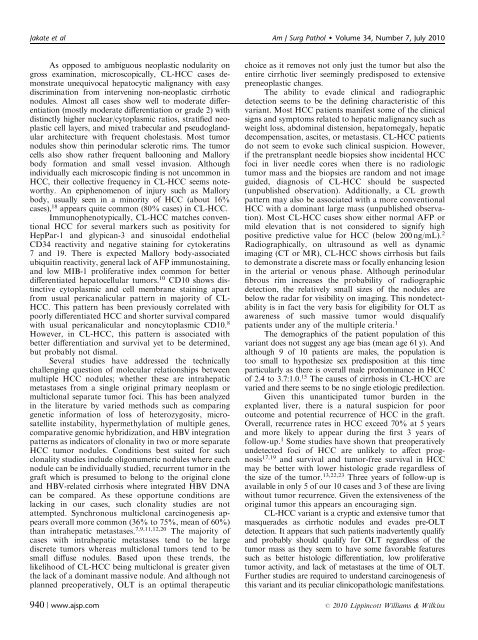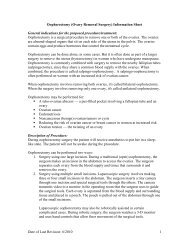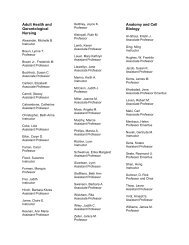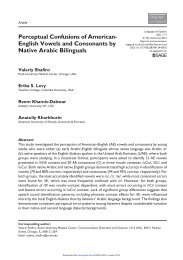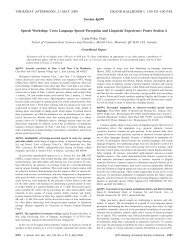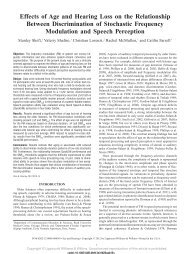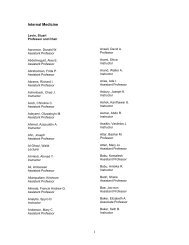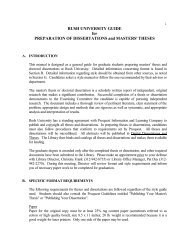Diffuse Cirrhosis-like Hepatocellular Carcinoma - Rush University ...
Diffuse Cirrhosis-like Hepatocellular Carcinoma - Rush University ...
Diffuse Cirrhosis-like Hepatocellular Carcinoma - Rush University ...
Create successful ePaper yourself
Turn your PDF publications into a flip-book with our unique Google optimized e-Paper software.
Jakate et al Am J Surg Pathol Volume 34, Number 7, July 2010<br />
As opposed to ambiguous neoplastic nodularity on<br />
gross examination, microscopically, CL-HCC cases demonstrate<br />
unequivocal hepatocytic malignancy with easy<br />
discrimination from intervening non-neoplastic cirrhotic<br />
nodules. Almost all cases show well to moderate differentiation<br />
(mostly moderate differentiation or grade 2) with<br />
distinctly higher nuclear/cytoplasmic ratios, stratified neoplastic<br />
cell layers, and mixed trabecular and pseudoglandular<br />
architecture with frequent cholestasis. Most tumor<br />
nodules show thin perinodular sclerotic rims. The tumor<br />
cells also show rather frequent ballooning and Mallory<br />
body formation and small vessel invasion. Although<br />
individually each microscopic finding is not uncommon in<br />
HCC, their collective frequency in CL-HCC seems noteworthy.<br />
An epiphenomenon of injury such as Mallory<br />
body, usually seen in a minority of HCC (about 16%<br />
cases), 18 appears quite common (80% cases) in CL-HCC.<br />
Immunophenotypically, CL-HCC matches conventional<br />
HCC for several markers such as positivity for<br />
HepPar-1 and glypican-3 and sinusoidal endothelial<br />
CD34 reactivity and negative staining for cytokeratins<br />
7 and 19. There is expected Mallory body-associated<br />
ubiquitin reactivity, general lack of AFP immunostaining,<br />
and low MIB-1 proliferative index common for better<br />
differentiated hepatocellular tumors. 10 CD10 shows distinctive<br />
cytoplasmic and cell membrane staining apart<br />
from usual pericanalicular pattern in majority of CL-<br />
HCC. This pattern has been previously correlated with<br />
poorly differentiated HCC and shorter survival compared<br />
with usual pericanalicular and noncytoplasmic CD10. 8<br />
However, in CL-HCC, this pattern is associated with<br />
better differentiation and survival yet to be determined,<br />
but probably not dismal.<br />
Several studies have addressed the technically<br />
challenging question of molecular relationships between<br />
multiple HCC nodules; whether these are intrahepatic<br />
metastases from a single original primary neoplasm or<br />
multiclonal separate tumor foci. This has been analyzed<br />
in the literature by varied methods such as comparing<br />
genetic information of loss of heterozygosity, microsatellite<br />
instability, hypermethylation of multiple genes,<br />
comparative genomic hybridization, and HBV integration<br />
patterns as indicators of clonality in two or more separate<br />
HCC tumor nodules. Conditions best suited for such<br />
clonality studies include oligonumeric nodules where each<br />
nodule can be individually studied, recurrent tumor in the<br />
graft which is presumed to belong to the original clone<br />
and HBV-related cirrhosis where integrated HBV DNA<br />
can be compared. As these opportune conditions are<br />
lacking in our cases, such clonality studies are not<br />
attempted. Synchronous multiclonal carcinogenesis appears<br />
overall more common (36% to 75%, mean of 60%)<br />
than intrahepatic metastases. 7,9,11,12,20 The majority of<br />
cases with intrahepatic metastases tend to be large<br />
discrete tumors whereas multiclonal tumors tend to be<br />
small diffuse nodules. Based upon these trends, the<br />
<strong>like</strong>lihood of CL-HCC being multiclonal is greater given<br />
the lack of a dominant massive nodule. And although not<br />
planned preoperatively, OLT is an optimal therapeutic<br />
940 | www.ajsp.com<br />
choice as it removes not only just the tumor but also the<br />
entire cirrhotic liver seemingly predisposed to extensive<br />
preneoplastic changes.<br />
The ability to evade clinical and radiographic<br />
detection seems to be the defining characteristic of this<br />
variant. Most HCC patients manifest some of the clinical<br />
signs and symptoms related to hepatic malignancy such as<br />
weight loss, abdominal distension, hepatomegaly, hepatic<br />
decompensation, ascites, or metastasis. CL-HCC patients<br />
do not seem to evoke such clinical suspicion. However,<br />
if the pretransplant needle biopsies show incidental HCC<br />
foci in liver needle cores when there is no radiologic<br />
tumor mass and the biopsies are random and not image<br />
guided, diagnosis of CL-HCC should be suspected<br />
(unpublished observation). Additionally, a CL growth<br />
pattern may also be associated with a more conventional<br />
HCC with a dominant large mass (unpublished observation).<br />
Most CL-HCC cases show either normal AFP or<br />
mild elevation that is not considered to signify high<br />
positive predictive value for HCC (below 200 ng/mL). 2<br />
Radiographically, on ultrasound as well as dynamic<br />
imaging (CT or MR), CL-HCC shows cirrhosis but fails<br />
to demonstrate a discrete mass or focally enhancing lesion<br />
in the arterial or venous phase. Although perinodular<br />
fibrous rim increases the probability of radiographic<br />
detection, the relatively small sizes of the nodules are<br />
below the radar for visibility on imaging. This nondetectability<br />
is in fact the very basis for eligibility for OLT as<br />
awareness of such massive tumor would disqualify<br />
patients under any of the multiple criteria. 1<br />
The demographics of the patient population of this<br />
variant does not suggest any age bias (mean age 61 y). And<br />
although 9 of 10 patients are males, the population is<br />
too small to hypothesize sex predisposition at this time<br />
particularly as there is overall male predominance in HCC<br />
of 2.4 to 3.7:1.0. 15 The causes of cirrhosis in CL-HCC are<br />
varied and there seems to be no single etiologic predilection.<br />
Given this unanticipated tumor burden in the<br />
explanted liver, there is a natural suspicion for poor<br />
outcome and potential recurrence of HCC in the graft.<br />
Overall, recurrence rates in HCC exceed 70% at 5 years<br />
and more <strong>like</strong>ly to appear during the first 3 years of<br />
follow-up. 1 Some studies have shown that preoperatively<br />
undetected foci of HCC are un<strong>like</strong>ly to affect prognosis<br />
17,19 and survival and tumor-free survival in HCC<br />
may be better with lower histologic grade regardless of<br />
the size of the tumor. 13,22,23 Three years of follow-up is<br />
available in only 5 of our 10 cases and 3 of these are living<br />
without tumor recurrence. Given the extensiveness of the<br />
original tumor this appears an encouraging sign.<br />
CL-HCC variant is a cryptic and extensive tumor that<br />
masquerades as cirrhotic nodules and evades pre-OLT<br />
detection. It appears that such patients inadvertently qualify<br />
and probably should qualify for OLT regardless of the<br />
tumormassastheyseemtohavesomefavorablefeatures<br />
such as better histologic differentiation, low proliferative<br />
tumor activity, and lack of metastases at the time of OLT.<br />
Further studies are required to understand carcinogenesis of<br />
this variant and its peculiar clinicopathologic manifestations.<br />
r 2010 Lippincott Williams & Wilkins


